中医术语名词英文翻译--3
- 格式:xls
- 大小:82.50 KB
- 文档页数:17
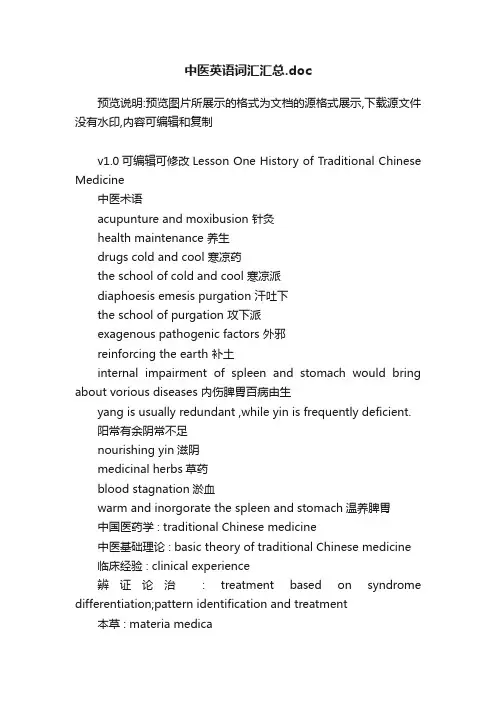
中医英语词汇汇总.doc预览说明:预览图片所展示的格式为文档的源格式展示,下载源文件没有水印,内容可编辑和复制v1.0可编辑可修改Lesson One History of Traditional Chinese Medicine中医术语acupunture and moxibusion 针灸health maintenance 养生drugs cold and cool 寒凉药the school of cold and cool 寒凉派diaphoesis emesis purgation 汗吐下the school of purgation 攻下派exagenous pathogenic factors 外邪reinforcing the earth 补土internal impairment of spleen and stomach would bring about vorious diseases 内伤脾胃百病由生yang is usually redundant ,while yin is frequently deficient.阳常有余阴常不足nourishing yin滋阴medicinal herbs草药blood stagnation淤血warm and inorgorate the spleen and stomach温养脾胃中国医药学 : traditional Chinese medicine中医基础理论 : basic theory of traditional Chinese medicine 临床经验 : clinical experience辨证论治: treatment based on syndrome differentiation;pattern identification and treatment本草 : materia medica中药 : Chinese materia medica; Chinese medicinals中草药 : Chinese medicinal herbs四气五味 : four properties and five tastes针灸 : acupuncture and moxibustion各家学说 : theories of different schools汗法 : diaphoresis; sweating therapy下法 : purgative therapy; precipitation吐法 : emetic therapy; vomiting therapy补土派 : school of invigorating the earth病因学说 : etiology养生: health cultivation; health improvement; health preservation医疗实践 : medical practice治疗原则 : therapeutic principles寒凉药物 : cold and cool medicinals滋阴降火 : nourishing yin to reduce fire瘀血 : blood stasis正气 : healthy qi病邪 : pathogenic factor整体观念 : holism; holistic concept气血运行 : circulation of qi and blood自然现象 : natural phenomenaLesson Two Materialism and Dialectics in Traditional Chinese Medicine 中医术语Materialism唯物主义dialectics辩证法celestial qi天气terrestrial qi地气the interaction between yin and yang阴阳相互作用the lucid yang ascends to constitute the earth 清阳为天qi transformation 气化essence 精prenatal essence 先天之精shen(spirit) 神pathological factor 邪气the opposition and unity of yin and yang 阴阳对立统一the motion and changes of yin and yang 阴阳运动变化organic whole 有机整体Five kinds of visceral qi 五脏之气five emotional changes 五志excessive rage impairs the liver 怒伤肝excessive joy impairs the heart 喜伤心excessive meditation impairs the spleen 思伤脾excessive melancholy impairs the lung 悲伤肺excessive fright impairs the kidney 恐伤肾routine treatment and contray treatment 正治反治tit-for-tat(or blow-for-blow) 正治reinforcing therapy 补法purging therapy 泄法differential application and therapeutic methods 异法方宜mental activity 神志活动the heart is the king organ responsible for the activityof thinking consciousness 心为君主之官主神志意识will意termed志thinking思wisdom智summer-heat暑热zheng qi ( healthy qi )正气Lesson Three The Basic Characteristics of TCMmaterilism and dialectics唯物论和辨证法the concept of organic whole整体观念treatment based on syndrone differentian辨证论治drawing yin from yang从阴引阳treating the nights for curing disease on the left从右治左treating the same disease with different therapies同病异治treating differnt disease with the same therapy异病同治clear away fire in the heart 清心火sprouting occurs in spring ,growth in summer,transformationg in late summer ,reaping in autumn and storing in winter 春生夏长秋收冬藏the relation between pachogenic factors and healthy qi 正邪关系the four diagnosic methods 四诊purging the small intestine 泻小肠spring is usually marked by warrachs , summerby heat ,late summerby dampness ,autumn by dryness and winter by cold 春暖夏暑长夏秋燥冬寒the interstitial space are open when one swears clothes in summer 天暑衣厚则奏理开哲学概念 : philosophical concept对立统一 : opposition and unity相互消长 : mutual waning and waxing阴阳属性 : nature of yin and yang相互转化 : mutual transformation相互联系 : interrelation相互制约 : mutual restraint动态平衡 : dynamic equilibrium阴平阳秘 : yin and yang in equilibrium相互依存 : interdependence阴阳的互根互用: interdependence between yin and yang阴阳离绝 : dissociation of yin and yang阴阳转化 : transformation between yin and yang阳消阴长 : yang waning while yin waxing阴胜则阳病 : predominance of yin leading to disorder of yang 阳胜则热 : predominance of yang generating heat寒极生热 : extreme cold generating heat热极生寒 : extreme heat generating cold相反相成 : opposite and supplementary to each other生理功能 : physiological functions病理变化 : pathological changes临床诊断 : clinical diagnosis阳胜生外热 : exuberance of yang leading to exterior heat阳中求阴 : obtaining yin from yang阳虚则寒 : yang deficiency leading to heat阳损及阴 : impairment of yang involving yin阴中之阳 : yang within yin阴阳两虚 : simultaneous deficiency of yin and yang阳虚发热 : fever due to yang deficiency阴阳学说 : theory of yin and yangv1.0可编辑可修改症状与病名stomatitis口腔炎proctoptosis脱肛dysentery痢疾hysteroptosis子宫脱垂measles麻疹ulcer溃疡the collapse of zhongqi中气下陷Lesson Four The Theory of Yin and Yang中医术语相互消长: growth and decline between yin and yang阴阳属性: yin and yang properties相互转化: inter-transformation相互依存: interdependence between yin and yang阴阳的无限可分性:the infinite divisibility of yin and yang阴平阳秘: yang steadies while yin calms阳消阴长: waning of yang will lead to waxing of yin阳胜则热:predominance of yang gives rise to heat syndrome寒极生热: extreme cold brings on heat热极生寒: extreme heat brings to cold阴中之阴: yin within yin阳中之阳: yang within yang阴中之阳: yin within yang阳中之阴: yang within yin阴阳互根: interdependence between yin and yang阴阳自和: natural harmony of yin and yang春生 sprouting in spring夏长 growing in summer秋收 reaping in autumn冬藏 storing in winter相互制约:mutual opposition and restriction between yin and yang动静升降出入motion and quiescence ,ascending and descending exiting and entering 孤阳不升,孤阴不长if only yang exists ,there will be no birth,if only yinexists,there will be no growth .动态平衡dynamic equilibrium阴胜则热 excess of yang causing heat阴阳失调: imbalance between yin and yangyin-yang disharmony wiseman 02/谢竹藩04阴阳两虚deficiency of both yin and yangdual vacuity of yin and yang wiseman 02阴阳乖戾dysequilibrium between yin and yangying-yang imbalance谢竹藩04阴阳离决separation of yin and yangwhile yin is (exuberant)prevails, there is cold wiseman 02阳胜则热 when yang prevails, there is heat wiseman 02阳胜则阴病 when yang prevails, yin ails wiseman 02阴胜则阳病 when yin prevails, yang ails wiseman 02阳虚则外寒when yang is vacuous, there is external cold wiseman 02阴虚则内热when yin is is vacuous, there is internal heat wiseman 02阴损及阳detriment to yang affects yin wiseman 02阳损及阴exuberant yin repelling yang wiseman 02阴虚火盛exuberant yin vacuity fire wiseman 02exuberance of fire/due to yin-deficiency 简明汉英中医词典2002 李照国阴虚火旺effulgent yin vacuity fire wiseman 02yin vacuity fire effulgent wiseman 02yin deficiency with effulgent fire 中医药常用名词术语英译2004 。
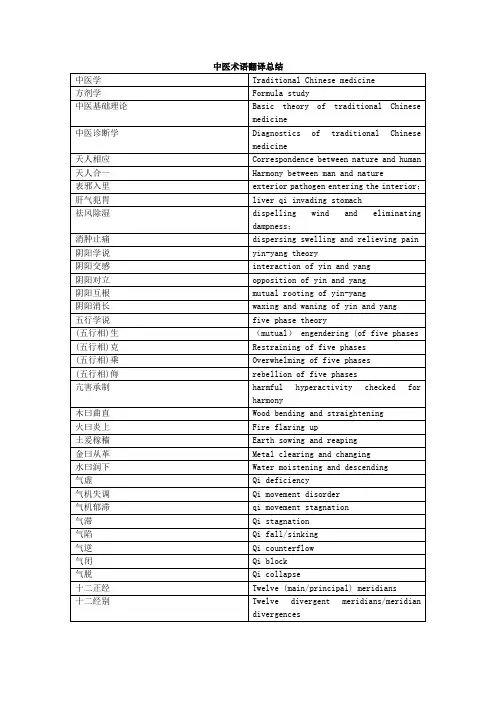
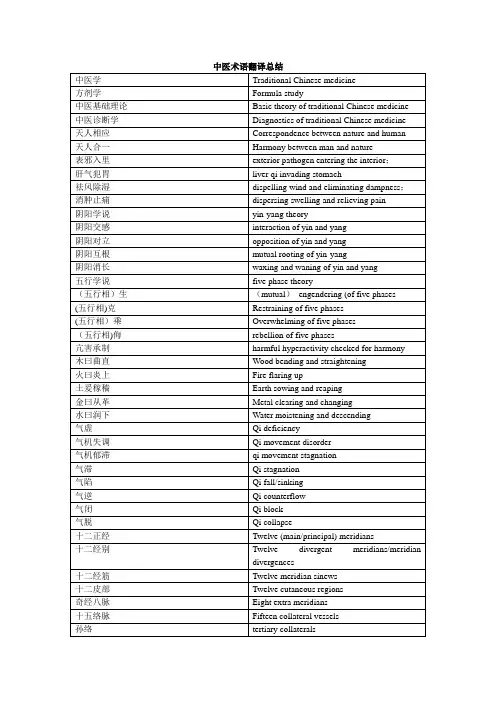
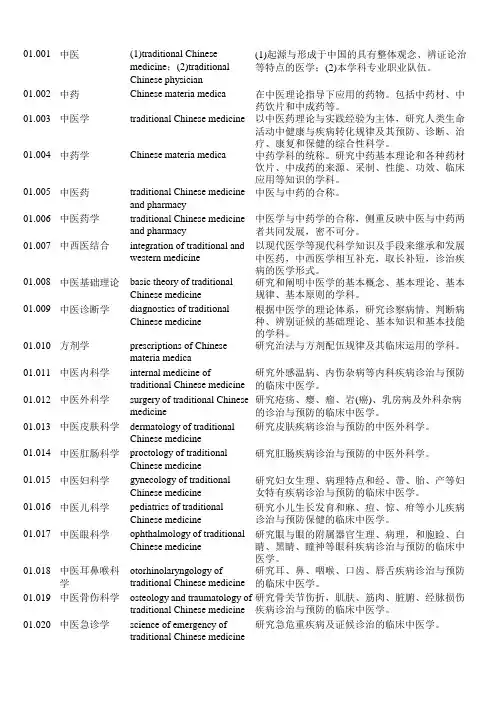
01.001中医(1)traditional Chinesemedicine;(2)traditionalChinese physician (1)起源与形成于中国的具有整体观念、辨证论治等特点的医学;(2)本学科专业职业队伍。
01.002中药Chinese materia medica在中医理论指导下应用的药物。
包括中药材、中药饮片和中成药等。
01.003中医学traditional Chinese medicine以中医药理论与实践经验为主体,研究人类生命活动中健康与疾病转化规律及其预防、诊断、治疗、康复和保健的综合性科学。
01.004中药学Chinese materia medica中药学科的统称。
研究中药基本理论和各种药材饮片、中成药的来源、采制、性能、功效、临床应用等知识的学科。
01.005中医药traditional Chinese medicineand pharmacy中医与中药的合称。
01.006中医药学traditional Chinese medicineand pharmacy 中医学与中药学的合称,侧重反映中医与中药两者共同发展,密不可分。
01.007中西医结合integration of traditional andwestern medicine 以现代医学等现代科学知识及手段来继承和发展中医药,中西医学相互补充,取长补短,诊治疾病的医学形式。
01.008中医基础理论basic theory of traditionalChinese medicine 研究和阐明中医学的基本概念、基本理论、基本规律、基本原则的学科。
01.009中医诊断学diagnostics of traditionalChinese medicine 根据中医学的理论体系,研究诊察病情、判断病种、辨别证候的基础理论、基本知识和基本技能的学科。
01.010方剂学prescriptions of Chinesemateria medica研究治法与方剂配伍规律及其临床运用的学科。
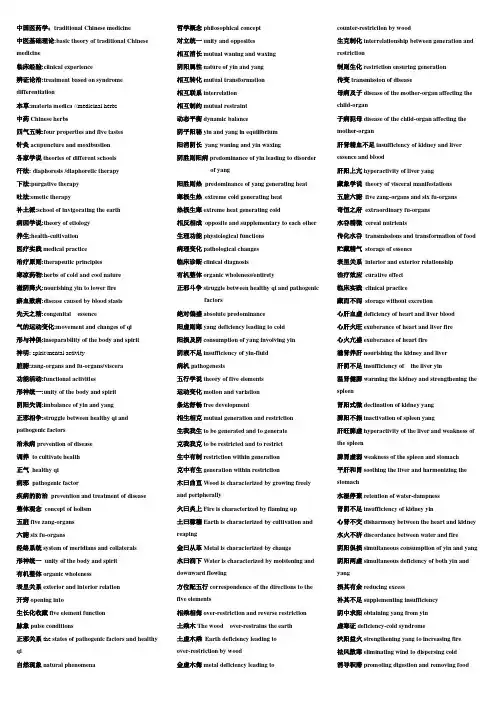
中国医药学:traditional Chinese medicine中医基础理论:basic theory of traditional Chinese medicine临床经验:clinical experience辨证论治:treatment based on syndrome differentiation本草:materia medica //medicinal herbs中药Chinese herbs四气五味:four properties and five tastes针灸acupuncture and moxibustion各家学说theories of different schools汗法: diaphoresis /diaphoretic therapy下法:purgative therapy吐法:emetic therapy补土派:school of invigorating the earth病因学说:theory of etiology养生:health-cultivation医疗实践medical practice治疗原则:therapeutic principles寒凉药物:herbs of cold and cool nature滋阴降火:nourishing yin to lower fire瘀血致病:disease caused by blood stasis先天之精:congenital essence气的运动变化:movement and changes of qi形与神俱:inseparability of the body and spirit神明: spirit/mental activity脏腑:zang-organs and fu-organs/viscera功能活动:functional activities形神统一:unity of the body and spirit阴阳失调:imbalance of yin and yang正邪相争:struggle between healthy qi and pathogenic factors治未病prevention of disease调养to cultivate health正气healthy qi病邪pathogenic factor疾病的防治prevention and treatment of disease整体观念concept of holism五脏five zang-organs六腑six fu-organs经络系统system of meridians and collaterals形神统一unity of the body and spirit有机整体organic wholeness表里关系exterior and interior relation开窍opening into生长化收藏five element function脉象pulse conditions正邪关系the states of pathogenic factors and healthy qi自然现象natural phenomena 哲学概念philosophical concept对立统一unity and opposites相互消长mutual waning and waxing阴阳属性nature of yin and yang相互转化mutual transformation相互联系interrelation相互制约mutual restraint动态平衡dynamic balance阴平阳秘yin and yang in equilibrium阳消阴长yang waning and yin waxing阴胜则阳病predominance of yin leading to disorderof yang阳胜则热predominance of yang generating heat寒极生热extreme cold generating heat热极生寒extreme heat generating cold相反相成opposite and supplementary to each other生理功能physiological functions病理变化pathological changes临床诊断clinical diagnosis有机整体organic wholeness/entirety正邪斗争struggle between healthy qi and pathogenicfactors绝对偏盛absolute predominance阳虚则寒yang deficiency leading to cold阳损及阴consumption of yang involving yin阴液不足insufficiency of yin-fluid病机pathogenesis五行学说theory of five elements运动变化motion and variation条达舒畅free development相生相克mutual generation and restriction生我我生to be generated and to generate克我我克to be restricted and to restrict生中有制restriction within generation克中有生generation within restriction木曰曲直Wood is characterized by growing freelyand peripherally火曰炎上Fire is characterized by flaming up土曰稼穑Earth is characterized by cultivation andreaping金曰从革Metal is characterized by change水曰润下Water is characterized by moistening anddownward flowing方位配五行correspondence of the directions to thefive elements相乘相侮over-restriction and reverse restriction土乘木The wood over-restrains the earth土虚木乘Earth deficiency leading toover-restriction by wood金虚木侮metal deficiency leading tocounter-restriction by wood生克制化interrelationship between generation andrestriction制则生化restriction ensuring generation传变transmission of disease母病及子disease of the mother-organ affecting thechild-organ子病犯母disease of the child-organ affecting themother-organ肝肾精血不足insufficiency of kidney and liveressence and blood肝阳上亢hyperactivity of liver yang藏象学说theory of visceral manifestations五脏六腑five zang-organs and six fu-organs奇恒之府extraordinary fu-organs水谷精微cereal nutrients传化水谷transmissions and transformation of food贮藏精气storage of essence表里关系interior and exterior relationship治疗效应curative effect临床实践clinical practice藏而不泻storage without excretion心肝血虚deficiency of heart and liver blood心肝火旺exuberance of heart and liver fire心火亢盛exuberance of heart fire滋肾养肝nourishing the kidney and liver肝阴不足insufficiency of the liver yin温肾健脾warming the kidney and strengthening thespleen肾阳式微declination of kidney yang脾阳不振inactivation of spleen yang肝旺脾虚hyperactivity of the liver and weakness ofthe spleen脾胃虚弱weakness of the spleen and stomach平肝和胃soothing the liver and harmonizing thestomach水湿停聚retention of water-dampness肾阴不足insufficiency of kidney yin心肾不交disharmony between the heart and kidney水火不济discordance between water and fire阴阳俱损simultaneous consumption of yin and yang阴阳两虚simultaneous deficiency of both yin andyang损其有余reducing excess补其不足supplementing insufficiency阴中求阳obtaining yang from yin虚寒证deficiency-cold syndrome扶阳益火strengthening yang to increasing fire祛风散寒eliminating wind to dispersing cold消导积滞promoting digestion and removing foodretention潜阳息风suppressing yang to quench wind阴阳的互根互用interdependence of yin and yang相互依存interdependence阴阳离决separation of yin and yang阴阳转化transformation between yin and yang发热恶寒fever and aversion to cold头身疼痛headache and body pain感受湿邪the attack of dampness清热泄火cleaning away heat and reducing fire腠理muscular interstices水湿停滞retention of water and dampness气血运行circulation of qi and blood疾病的本质与现象:nature and manifestations of disease阴阳的相对平衡:relative balance between yin and yang疾病的发生与发展:occurrence and development of disease同病异治:treating the same disease with different therapies异病同治:treating different diseases with the same therapy1.中国医药学有数千年的历史,是中国人民长期同疾病作斗争的经验总结。
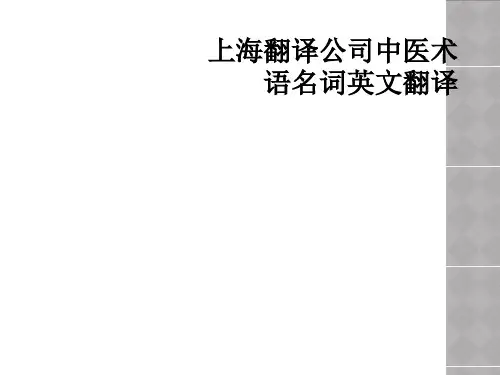
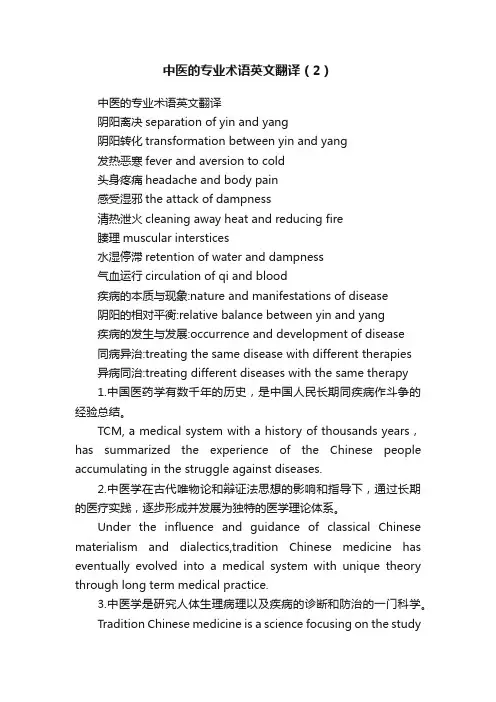
中医的专业术语英文翻译(2)中医的专业术语英文翻译阴阳离决separation of yin and yang阴阳转化transformation between yin and yang发热恶寒fever and aversion to cold头身疼痛headache and body pain感受湿邪the attack of dampness清热泄火cleaning away heat and reducing fire腠理muscular interstices水湿停滞retention of water and dampness气血运行circulation of qi and blood疾病的本质与现象:nature and manifestations of disease阴阳的相对平衡:relative balance between yin and yang疾病的发生与发展:occurrence and development of disease同病异治:treating the same disease with different therapies异病同治:treating different diseases with the same therapy1.中国医药学有数千年的历史,是中国人民长期同疾病作斗争的经验总结。
TCM, a medical system with a history of thousands years,has summarized the experience of the Chinese people accumulating in the struggle against diseases.2.中医学在古代唯物论和辩证法思想的影响和指导下,通过长期的医疗实践,逐步形成并发展为独特的医学理论体系。
Under the influence and guidance of classical Chinese materialism and dialectics,tradition Chinese medicine has eventually evolved into a medical system with unique theory through long term medical practice.3.中医学是研究人体生理病理以及疾病的诊断和防治的一门科学。
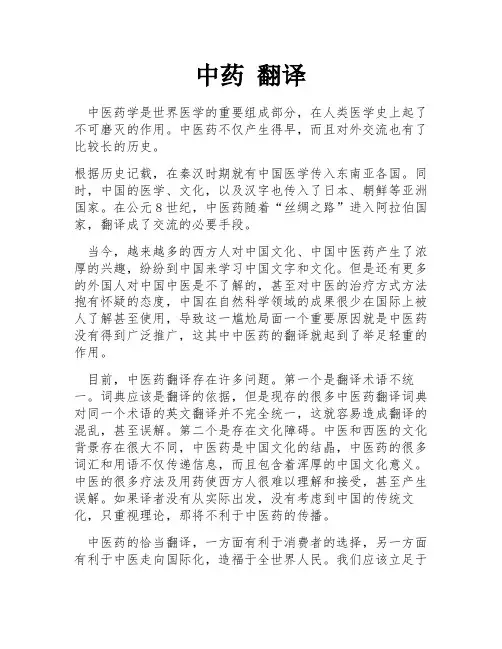
中药翻译中医药学是世界医学的重要组成部分,在人类医学史上起了不可磨灭的作用。
中医药不仅产生得早,而且对外交流也有了比较长的历史。
根据历史记载,在秦汉时期就有中国医学传入东南亚各国。
同时,中国的医学、文化,以及汉字也传入了日本、朝鲜等亚洲国家。
在公元8世纪,中医药随着“丝绸之路”进入阿拉伯国家,翻译成了交流的必要手段。
当今,越来越多的西方人对中国文化、中国中医药产生了浓厚的兴趣,纷纷到中国来学习中国文字和文化。
但是还有更多的外国人对中国中医是不了解的,甚至对中医的治疗方式方法抱有怀疑的态度,中国在自然科学领域的成果很少在国际上被人了解甚至使用,导致这一尴尬局面一个重要原因就是中医药没有得到广泛推广,这其中中医药的翻译就起到了举足轻重的作用。
目前,中医药翻译存在许多问题。
第一个是翻译术语不统一。
词典应该是翻译的依据,但是现存的很多中医药翻译词典对同一个术语的英文翻译并不完全统一,这就容易造成翻译的混乱,甚至误解。
第二个是存在文化障碍。
中医和西医的文化背景存在很大不同,中医药是中国文化的结晶,中医药的很多词汇和用语不仅传递信息,而且包含着浑厚的中国文化意义。
中医的很多疗法及用药使西方人很难以理解和接受,甚至产生误解。
如果译者没有从实际出发,没有考虑到中国的传统文化,只重视理论,那将不利于中医药的传播。
中医药的恰当翻译,一方面有利于消费者的选择,另一方面有利于中医走向国际化,造福于全世界人民。
我们应该立足于前人的基础,不断深化中医英译理论,致力于中医术语英译的规范化。
附:中医药常用词汇的英文翻译(1) 中国医药学traditional Chinese medicine(2) 中医基础理论basic theory of traditional Chinese medicine(3) 临床经验clinical experience(4) 辨证论治treatment based on syndromedifferentiation(5) 本草materia medica //medicinal herbs(6) 中药Chinese herbs(7) 四气五味four properties and five tastes(8) 针灸acupuncture and moxibustion(9) 各家学说theories of different schools(10) 汗法 diaphoresis /diaphoretic therapy(11) 下法purgative therapy(12) 吐法emetic therapy(13) 补土派school of invigorating the earth(14) 病因学说theory of etiology(15) 养生health-cultivation(16) 寒凉药物herbs of cold and cool nature(17) 滋阴降火nourishing yin to lower fire(18) 瘀血致病disease caused by blood stasis(19) 先天之精congenital essence(20) 气的运动变化movement and changes of qi(21) 形与神俱inseparability of the body and spirit(22) 脏腑zang-organs and fu-organs/viscera(23) 形神统一unity of the body and spirit(24) 阴阳失调imbalance of yin and yang(25) 正邪相争struggle between healthy qi and pathogenic factors(26) 治未病prevention of disease(27) 调养 to cultivate health(28) 正气 healthy qi(29) 病邪 pathogenic factor(30) 疾病的防治 prevention and treatment of disease(31) 整体观念 concept of holism(32) 五脏five zang-organs(33) 六腑six fu-organs(34) 经络系统system of meridians and collaterals(35) 形神统一unity of the body and spirit(36) 有机整体organic wholeness(37) 表里关系exterior and interior relation(38) 开窍opening into(39) 生长化收藏five element function(40) 脉象pulse conditions(41) 正邪关系the states of pathogenic factors and healthy qi(42) 自然现象natural phenomena(43) 哲学概念philosophical concept(44) 对立统一unity and opposites(45) 相互消长mutual waning and waxing(46) 阴阳属性nature of yin and yang(47) 相互转化mutual transformation(48) 相互联系interrelation(49) 相互制约mutual restraint(50) 动态平衡dynamic balance(51) 阴平阳秘yin and yang in equilibrium(52) 阳消阴长 yang waning and yin waxing(53) 阴胜则阳病predominance of yin leading to disorder of yang(54) 阳胜则热 predominance of yang generating heat(55) 寒极生热 extreme cold generating heat(56) 热极生寒extreme heat generating cold(57) 相反相成 opposite and supplementary to each other(58) 生理功能physiological functions(59) 病理变化pathological changes(60) 临床诊断clinical diagnosis(61) 有机整体organic wholeness/entirety(62) 正邪斗争struggle between healthy qi and pathogenic factors(63) 绝对偏盛absolute predominance(64) 阳虚则寒yang deficiency leading to cold(65) 阳损及阴consumption of yang involving yin(66) 阴液不足insufficiency of yin-fluid(67) 病机pathogenesis(68) 五行学说theory of five elements(69) 运动变化motion and variation(70) 条达舒畅free development(71) 相生相克mutual generation and restriction(72) 生我我生to be generated and to generate(73) 克我我克to be restricted and to restrict(74) 生中有制restriction within generation(75) 克中有生generation within restriction(76) 木曰曲直Wood is characterized by growing freely and peripherally(77) 火曰炎上Fire is characterized by flaming up(78) 土曰稼穑Earth is characterized by cultivation and reaping(79) 金曰从革Metal is characterized by change(80) 水曰润下Water is characterized by moistening and downward flowing(81) 方位配五行correspondence of the directions to the five elements(82) 相乘相侮over-restriction and reverse restriction(83) 土乘木The wood over-restrains the earth(84) 土虚木乘 Earth deficiency leading to over-restriction by wood(85) 金虚木侮metal deficiency leading to counter-restriction by wood(86) 生克制化interrelationship between generation and restriction(87) 制则生化restriction ensuring generation(88) 传变transmission of disease(89) 母病及子disease of the mother-organ affecting the child-organ(90) 子病犯母disease of the child-organ affecting the mother-organ(91) 肝肾精血不足insufficiency of kidney and liver essence and blood(92) 肝阳上亢hyperactivity of liver yang(93) 藏象学说 theory of visceral manifestations(94) 五脏六腑 five zang-organs and six fu-organs(95) 奇恒之府 extraordinary fu-organs(96) 水谷精微 cereal nutrients(97) 传化水谷 transmissions and transformation of food(98) 贮藏精气 storage of essence(99) 表里关系 interior and exterior relationship(100) 治疗效应 curative effect(101) 临床实践 clinical practice(102) 藏而不泻 storage without excretion(103) 心肝血虚deficiency of heart and liver blood(104) 心肝火旺exuberance of heart and liver fire(105) 心火亢盛exuberance of heart fire(106) 滋肾养肝nourishing the kidney and liver(107) 肝阴不足insufficiency of the liver yin(108) 温肾健脾warming the kidney and strengthening the spleen(109) 肾阳式微declination of kidney yang(110) 脾阳不振inactivation of spleen yang(111) 肝旺脾虚hyperactivity of the liver and weakness of the spleen(112) 脾胃虚弱weakness of the spleen and stomach(113) 平肝和胃soothing the liver and harmonizing the stomach(114) 水湿停聚retention of water-dampness(115) 肾阴不足insufficiency of kidney yin(116) 心肾不交disharmony between the heart and kidney(117) 水火不济discordance between water and fire(118) 阴阳俱损simultaneous consumption of yin and yang(119) 阴阳两虚simultaneous deficiency of both yin and yang(120) 损其有余reducing excess(121) 补其不足supplementing insufficiency(122) 阴中求阳obtaining yang from yin(123) 虚寒证deficiency-cold syndrome(124) 扶阳益火strengthening yang to increasing fire (125) 祛风散寒eliminating wind to dispersing cold(126) 消导积滞promoting digestion and removing food retention(127) 潜阳息风suppressing yang to quench wind (128) 阴阳的互根互用interdependence of yin and yang (129) 相互依存interdependence(130) 阴阳离决separation of yin and yang(131) 阴阳转化transformation between yin and yang (132) 发热恶寒fever and aversion to cold(133) 头身疼痛headache and body pain(134) 感受湿邪the attack of dampness(135) 清热泄火cleaning away heat and reducing fire (136) 腠理muscular interstices(137) 水湿停滞retention of water and dampness (138) 气血运行circulation of qi and blood(139) 疾病的本质与现象nature and manifestations of disease(140) 阴阳的相对平衡relative balance between yin and yang(141) 疾病的发生与发展occurrence and development of disease(142) 同病异治treating the same disease with different therapies(143) 异病同治treating different diseases with the same therapy。
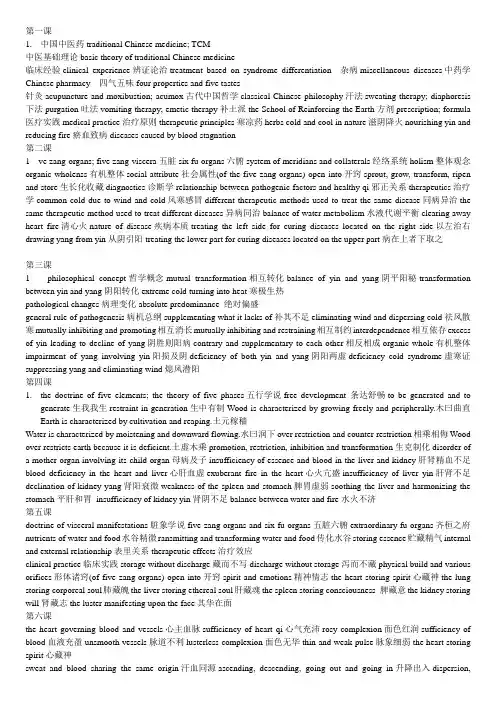
第一课1.中国中医药traditional Chinese medicine; TCM中医基础理论basic theory of traditional Chinese medicine临床经验clinical experience辨证论治treatment based on syndrome differentiation 杂病miscellaneous diseases中药学Chinese pharmacy 四气五味four properties and five tastes针灸acupuncture and moxibustion; acumox古代中国哲学classical Chinese philosophy汗法sweating therapy; diaphoresis 下法purgation吐法vomiting therapy; emetic therapy补土派the School of Reinforcing the Earth方剂prescription; formula 医疗实践medical practice治疗原则therapeutic principles寒凉药herbs cold and cool in nature滋阴降火nourishing yin and reducing fire瘀血致病diseases caused by blood stagnation第二课1 ve zang-organs; five zang-viscera五脏six fu-organs六腑system of meridians and collaterals经络系统holism整体观念organic wholenss有机整体social attribute社会属性(of the five zang-organs) open into开窍sprout, grow, transform, ripen and store生长化收藏diagnostics诊断学relationship between pathogenic factors and healthy qi邪正关系therapeutics治疗学common cold due to wind and cold风寒感冒different therapeutic methods used to treat the same disease同病异治the same therapeutic method used to treat different diseases异病同治balance of water metabolism水液代谢平衡clearing away heart fire清心火nature of disease疾病本质treating the left side for curing diseases located on the right side以左治右drawing yang from yin从阴引阳treating the lower part for curing diseases located on the upper part病在上者下取之第三课1 philosophical concept哲学概念mutual transformation相互转化balance of yin and yang阴平阳秘transformation between yin and yang阴阳转化extreme cold turning into heat寒极生热pathological changes病理变化absolute predominance 绝对偏盛general rule of pathogenesis病机总纲supplementing what it lacks of补其不足eliminating wind and dispersing cold祛风散寒mutually inhibiting and promoting相互消长mutually inhibiting and restraining相互制约interdependence相互依存excess of yin leading to decline of yang阴胜则阳病contrary and supplementary to each other相反相成organic whole有机整体impairment of yang involving yin阳损及阴deficiency of both yin and yang阴阳两虚deficiency cold syndrome虚寒证suppressing yang and eliminating wind熄风潜阳第四课1.the doctrine of five elements; the theory of five phases五行学说free development 条达舒畅to be generated and togenerate生我我生restraint in generation生中有制Wood is characterized by growing freely and peripherally.木曰曲直Earth is characterized by cultivation and reaping.土元稼穑Water is characterized by moistening and downward flowing.水曰润下over restriction and counter-restriction相乘相侮Wood over restricts earth because it is deficient.土虚木乘promotion, restriction, inhibition and transformation生克制化disorder of a mother-organ involving its child-organ母病及子insufficiency of essence and blood in the liver and kidney肝肾精血不足blood deficiency in the heart and liver心肝血虚exuberant fire in the heart心火亢盛insufficiency of liver yin肝肾不足declination of kidney yang肾阳衰微weakness of the spleen and stomach脾胃虚弱soothing the liver and harmonizing the stomach平肝和胃insufficiency of kidney yin肾阴不足balance between water and fire水火不济第五课doctrine of visceral manifestations脏象学说five zang-organs and six fu-organs五脏六腑extraordinary fu-organs齐桓之府nutrients of water and food水谷精微ransmitting and transforming water and food传化水谷storing essence贮藏精气internal and external relationship表里关系therapeutic effects治疗效应clinical practice临床实践storage without discharge藏而不写discharge without storage泻而不藏physical build and various orifices形体诸窍(of five zang-organs) open into开窍spirit and emotions精神情志the heart storing spirit心藏神the lung storing corporeal soul肺藏魄the liver storing ethereal soul肝藏魂the spleen storing consciousness 脾藏意the kidney storing will肾藏志the luster manifesting upon the face其华在面第六课the heart governing blood and vessels心主血脉sufficiency of heart qi心气充沛rosy complexion面色红润sufficiency of blood血液充盈unsmooth vessels脉道不利lusterless complexion面色无华thin and weak pulse脉象细弱the heart storing spirit心藏神sweat and blood sharing the same origin汗血同源ascending, descending, going out and going in升降出入dispersion,purification and descent宣发肃降regulating water passage通调水道the spleen governing transportation and transformation 脾主运化nutrients of water and food水谷精微stoppage of water and fluid水液停滞acquired base of life后天之本regulating qi activity调畅气机upward adverse flow of liver qi肝气上逆innate essence先天之精the kidney receiving qi肾主纳气第七课extraordinary fu-organs齐桓之府isolated fu-organ孤府digest water and food腐熟水谷anus破门remaining part of liver qi肝之余气upper energizer上焦separating the lucid from the turbid泌别清浊residue of foods食物残渣The large intestine governs thin body fluid大肠主津bile精汁The small intestine governs thick body fluid小肠主液primary digestion 初步消化essential qi精气the seven important portals七冲门The gallbladder is responsible for making judgment胆主决断discharge waste排泄糟粕occurrence of menstruation月经来潮epiglottis 吸门morphological hollowness形态中空transporting and transforming water and food传化水谷第八课innateness先天禀赋nutrients; refined substance精微物质blood circulation血液循环water metabolism水液代谢way of qi movement气的运动形式ascending, descending, exiting and entering movements of qi的升降出入运动normal function of qi activity气机条畅primary motive force of life生命的原动力warming and nourishing the viscera温养脏腑qi of the viscera and meridians脏腑经络之气qi activity气机qi transformation气化innate qi先天之气acquired qi后天之气healthy qi正气pathogenic factors邪气primordial qi元气thoracic qi宗气nutritive qi营气defensive qi卫气第九课qi promoting the production of blood气生血qi promoting the flow of blood气行血qi commanding blood气摄血blood carrying qi血载气blood generating qi血生气qi promoting the production of body fluid气生津液qi promoting the flow of body fluid气行津液qi commanding body fluid气摄津液body fluid carrying qi津液载气body fluid generating qi津液生气body fluid and blood sharing the same origin津血同源exhaustion of qi due to loss of body fluid气随液脱exhaustion of qi due to hemorrhage气随血脱loss of qi due to profuse sweating气随津泄Normal flow of qi ensures normal flow of blood while stagnation of qi causes stagnation of blood.气行则血行气滞则血瘀Qi commands the blood and the blood carries qi.气为血帅血为气母Normal flow of qi ensures normal flow of body fluid while stagnation of qi causes stagnation of body fluid.气行则水行气滞则水滞nourishing qi to stop collapse益气固脱Sweating therapy should be not be used to treat patients suffering from hemorrhage.亡血家不可发汗Sweating therapy should not be used to treat hemorrhage.夺血者无汗第十课theory of meridians and collaterals经络学说system of meridians and collaterals经络系统transporting qi and blood to the whole body运行全身气血being connected with the viscera and limbs联络脏腑肢节running routes循行路线twelve regular meridians十二正经the regions through or along which the meridians run and the order by which the meridians are connected with each other循行部位和交接顺序(of a collateral) pertaining to a certain meridian络属关系eight extraordinary vessels (meridians)奇经八脉branches of the twelve regular meridians十二经别divergent collaterals别络skin divisions of the twelve regular meridians十二皮部tendons of the twelve regular meridians十二经筋qi of meridians经络之气syndrome differentiation of meridians and collaterals经络辨证meridian conduction经络感传meridian manifestations经络现象blockage of meridians经络阻滞soothing meridians and activating collaterals舒筋活络collateral pricking and cupping therapy刺络拔罐第十课theory of meridians and collaterals经络学说system of meridians and collaterals经络系统transporting qi and blood to the whole body运行全身气血being connected with the viscera and limbs联络脏腑肢节running routes循行路线twelve regular meridians十二正经the regions through or along which the meridians run and the order by which the meridians are connected with each other循行部位和交接顺序(of a collateral) pertaining to a certain meridian络属关系eight extraordinary vessels (meridians)奇经八脉branches of the twelve regular meridians十二经别divergent collaterals别络skin divisions of the twelve regular meridians十二皮部tendons of the twelve regular meridians十二经筋qi of meridians经络之气14 syndrome differentiation of meridians and collaterals经络辨证meridian conduction经络感传meridian manifestations经络现象blockage of meridians经络阻滞soothing meridians and activating collaterals舒筋活络collateral pricking and cupping therapy刺络拔罐Lesson 11six exogenous pathogenic factors外感六淫improper diet and overstrain 饮食劳倦common cold due to wind-cold风寒感冒diarrhea due to damp-heat/damp-heat diarrhea 湿热泄泻five endogenous pathogenic factors内生五邪pathogenic wind attacking the exterior 风邪外袭migratory arthralgia/joint pain游走性关节痛wind being the leading pathogenic factor风为百病之长attacked/invaded by pathogenic cold感受寒邪decline of yang qi阳气衰退cold tending to stagnate by nature寒性凝滞stagnation of interstitial space 腠理闭塞spasm and contraction of muscles and tendons经脉拘急收引pathogenic dampness obstructing the spleen湿邪困脾inactivation of spleen-yang脾阳不振production of endogenous heat due to yin deficiency阴虚生内热extreme heat producing wind热极生风internal impairment due to yin deficiency 七情内伤improper diet饮食不节engorgement 暴饮暴食Lesson 12occurrence, development, and changes of disease疾病的发生发展变化(body )constitutional state 体质强弱dysfunction of qi and blood气血功能紊乱various pathological changes多种多样的病理变化exuberance or decline of pathogenic factors and healthy qi/ strength contrast between pathogenic factors and healthy qi邪正盛衰deficiency or excess changes of disease /transformation between deficiency and excess during a disease病症的虚实变化the human body’resistance against diseases 人体的抗病能力feverish sensation over the five centers (palms, soles, and chest)五心烦热deficiency complicated with excess虚实夹杂turnover of disease/prognosis of disease疾病转归relative predominance of yin or yang阴阳偏盛extreme changes of five emotions五志过极depletion of essence causing deficiency精气夺则虚mutual consumption of yin and yang阴阳互损true heat and false cold; false cold and true heat真热假寒或假寒真热stagnation of qi activity气机瘀滞不畅disorder of fluid metabolism津液代谢失常endogenous cold/ cold originating from the interior 寒从中生fluid consumption producing dryness津伤化燥stirring of endogenous wind/disturbance of endogenous wind风气内动Lesson 13spirit, complexion, and physical conditions 神色形态mental activities 精神活动sufficient essence and abundant qi精气充足apathetic facial expressions表情淡漠normal complexion and varied normal complexion 主色与客色convulsion of the limbs四肢抽搐stirring of wind due to damp-heat 湿热风动interior sinking of pathogenic toxin邪毒内陷scaly skin/ squamous and dry skin肌肤甲错hunger without appetite 饥不欲食combined use of the four diagnostic methods四诊合参facial expressions面部表情favorable prognosis预后良好dispiritedness 精神不振five colors indicating diseases / diagnostic significance of five colors五色主病facial distortion口角歪斜flaming of deficient fire虚火上炎retention of heat in the large intestine大肠热结mirror-like tongue光剥舌pulse manifestations脉象Lesson 14prevention before occurrence未病先防harmony between qi and blood气血平和regulating mental conditions调摄精神smooth circulation of blood血脉流畅smooth movement of joints关节通利smooth flow of qi/ free activity of qi气机条畅prolonging life and promoting longevity益寿延年preventive and therapeutic principles防治原则treatment should focus on the root of diseases治病求本treating secondary symptoms in acute disease急则治其标treating primary symptoms in chronic disease缓则治其本simultaneous treatment of primary and secondary symptoms 标本兼治deficiency of healthy qi and excess of pathogenic factors正虚邪实removing parasites to eliminate accumulation驱虫消积accumulation of phlegm-dampness in the lung痰湿壅盛blood serving as the mother of qi血为气母treatment in accordance with seasons, locality and individuality.因时因地因人制宜avoiding cold herbs in cold weather用寒远寒exogenous dry disease in autumn 外感秋燥moistening dryness with pungent and cool herbs辛凉润燥Lesson 15ⅰ.treatment with syndrome differentiation/ 辨证论治disease involving both exterior and interior表里同病simultaneous occurrence of cold and heat/ mixture of cold and heat寒热错杂regression of interior pathogenic factors to the exterior 里邪出表true cold and false heat 真寒假热aversion to cold and aversion to heat恶寒与恶热tasteless sensation in the mouth without thirst 口淡不渴transformation of stagnated pathogenic cold into heat 寒邪郁而化热exterior-deficiency syndrome due to exogenous pathogens外感表虚feverish sensation over five centers五心烦热location and nature of disease病位与病性mixture of deficiency and excess虚实夹杂invasion of exterior pathogenic factors into the interior表邪入里cold syndrome transforming into heat syndrome寒症化热true heat and false cold真热假寒heat syndrome transforming into cold syndrome热证转寒pale tongue with white, moist and slippery fur舌淡苔白而润滑rapid and weak pulse脉数无力tidal fever and night sweating 潮热盗汗coma with delirium神昏谵语Lesson 16Chinese medicinal herbs 中草药four properties and five flavors 四气五味the part used for medical purpose入药部分collection of herbs药物采集processing of herbs 炮制eliminating impurity清除杂质mild effect作用和缓relieving exterior syndrome by dispersion发散解表astringing and checking收敛固涩lubricant purgation by softening hardness 软坚润下drying dampness to invigorate the spleen燥湿健脾ascending, descending, sinking and floating升降沉浮channel tropism/channel distribution of medicines归经medication contraindication用药禁忌dosage 药物剂量pungent and warm herbs with the function of relieving exterior syndrome 辛温解表药herbs for expelling wind and dampness祛风湿药eighteen incompatible herbs and nineteen herbs of mutual antagonism十八反十九畏herbs for clearing away heat and cooling blood清热凉血药herbs for eliminating phlegm and stopping cough祛痰止咳药Lesson 17Science of prescription方剂学compatibility配伍关系prescription-formulating principle组成规律modification of prescriptions方剂的加减drug form and dosage 剂型与剂量monarch, minister, assistant and guide君臣佐使toxicity of medicinal herbs药物毒性moderating the property of herbs 缓和药性guiding action引经报使mediating all herbs in a prescription调和诸药warming channels to dissipate cold温经散寒dispersing lung to relieve asthma宣肺平喘flexible modification灵活化裁clearing away and dispersing stagnated heat清散郁热modification according to symptoms随症加减processed herbs药物饮片power for oral taking内服散剂medicinal extract for external application 外用膏剂mixed in boiled water for oral taking 开水冲服condensed extract浓缩浸膏Lesson 18acupuncture and moxibustion therapy针灸疗法reinforcing and reducing techniques for needling针刺补泻needling techniques针刺手法methods for needle-inserting进针手法alleviating pain with acupuncture针刺止痛acupuncture anesthesia针刺麻醉needling sensation 针感intradermal needle皮内针angle and depth ofneedling针刺的角度和深度insertion of needle with double hands双手进针manipulation of needle行针ear acupuncture therapy耳针疗法lifting, thrusting, twisting and rotating 提插捻转water-acupuncture therapy水针疗法scalp-acupuncture therapy头针疗法blistering moxibustion 化脓灸scarring moxibustion瘢痕灸moxibustion with moxa cone艾炷灸lamp moxibustion灯火灸needle-warming moxibustion温针灸Lesson 19tuina manipulations推拿手法alleviating pain减轻疼痛exercise for practicing tuina功法训练relaxing muscles放松肌肉relieving muscular tension解除肌肉紧张restricted activity 活动受限dislocation of joint关节脱位protrusion of lumbar vertebral disc腰椎间盘突出rotating reduction旋转复位injury of soft tissue软组织损伤adhesion and stiffness of joint 关节粘连僵硬lubricating joint滑利关节reinforcing and reducing manipulation手法补写horizontal pushing with the thumb拇指平推法pushing manipulation with one finger一指禅推法point-pressing manipulation点按法kneading manipulation with the large thenar大鱼际揉法alternated rubbing and kneading 交替搓揉injury of lumbar muscles腰肌劳损vertical exertion of force 垂直用力Lesson 20differentiation of tongue manifestations辨舌象differentiation of pulse manifestations辨脉象balancing expelling pathogenic factors with strengthening healthy qi 正邪兼顾thoracic retention of fluid支饮chills in the back/aversion to cold in the back背部恶寒dark complexion/black complexion面色黧黑slippery tongue coating/ moist and glossy tongue coating舌苔水滑taut pulse/wiry pulse 弦脉dispelling pathogenic cold发散寒邪invigorating the stomach to resolve fluid健胃化饮nourishing kidney water to astringe lung qi滋肾水以敛肺气nourishing yin blood to protect liver yin养阴血以护肝阴expelling pathogenic factors without impairing the healthy qi祛邪而不伤正invigorating qi to harmonize the middle-jiao益气和中mediating all herbs in a prescription调和诸药prescriptions for drastic diaphoresis发汗峻剂cold in the exterior and fluid in the interior表寒里饮cold water attacking the stomach水寒犯胃effective prescriptions有效方剂cold limbs in syncope 手足厥冷Lesson 21complementary therapy补充疗法alternative medicine 替代医学rehabilitation process康复过程side-effects副作用active ingredients 有效成分evidence-based data 询证数据double-blind randomized trial双盲随机试验stroke onset中风发病hyper-acute stage超急性期proprietary medicine 专利药品animal models动物模型risk of bleeding出血的危险因素mechanism of action作用机制low-quality medical treatments医疗质量低下physiotherapy物理疗法neuroplasticity 神经可塑性mainstream medicine 主流药物antiplatelet agent抗血小板剂microbial analysis微生物分析heavy metal research 重金属研究。
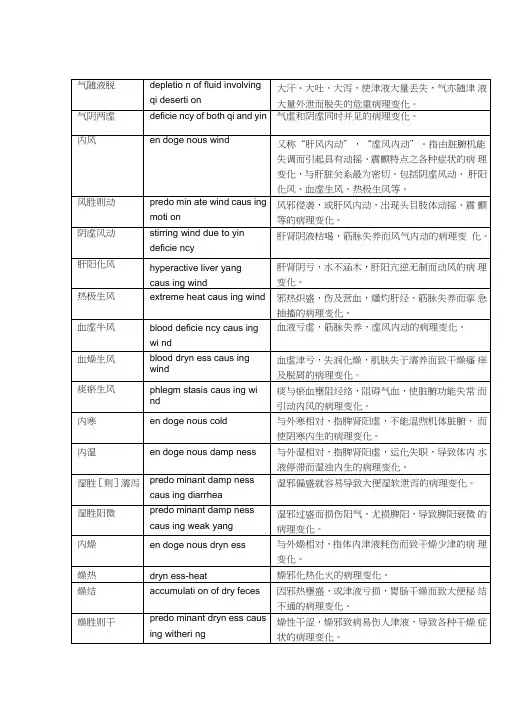
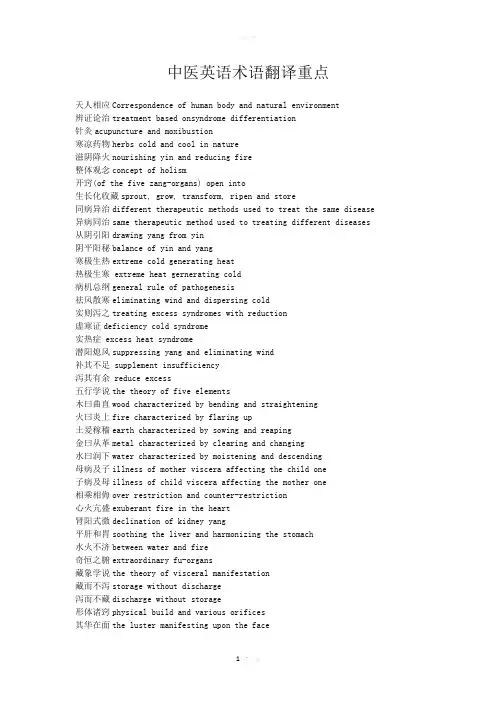
中医英语术语翻译重点天人相应Correspondence of human body and natural environment辨证论治treatment based onsyndrome differentiation针灸acupuncture and moxibustion寒凉药物herbs cold and cool in nature滋阴降火nourishing yin and reducing fire整体观念concept of holism开窍(of the five zang-organs) open into生长化收藏sprout, grow, transform, ripen and store同病异治different therapeutic methods used to treat the same disease 异病同治same therapeutic method used to treating different diseases 从阴引阳drawing yang from yin阴平阳秘balance of yin and yang寒极生热extreme cold generating heat热极生寒 extreme heat gernerating cold病机总纲general rule of pathogenesis祛风散寒eliminating wind and dispersing cold实则泻之treating excess syndromes with reduction虚寒证deficiency cold syndrome实热症 excess heat syndrome潜阳熄风suppressing yang and eliminating wind补其不足 supplement insufficiency泻其有余 reduce excess五行学说the theory of five elements木曰曲直wood characterized by bending and straightening火曰炎上fire characterized by flaring up土爰稼穑earth characterized by sowing and reaping金曰从革metal characterized by clearing and changing水曰润下water characterized by moistening and descending母病及子illness of mother viscera affecting the child one子病及母illness of child viscera affecting the mother one相乘相侮over restriction and counter-restriction心火亢盛exuberant fire in the heart肾阳式微declination of kidney yang平肝和胃soothing the liver and harmonizing the stomach水火不济between water and fire奇恒之腑extraordinary fu-organs藏象学说the theory of visceral manifestation藏而不泻storage without discharge泻而不藏discharge without storage形体诸窍physical build and various orifices其华在面the luster manifesting upon the face满而不实 full but not to be solid实而不满solid but not to be full心主血脉heart governing blood and vessels肺司呼吸lung controlling breathing脾主运化spleen governing transportation and transformation肝主疏泄liver controlling conveyance and dispersion肾主藏精kidney governing storing essence面色无华lusterless complexion汗血同源sweat and blood sharing the same origin升降出入ascending, descending, going out and going in宣发肃降dispersion, purification and descent后天之本acquired base of life肝气逆上upward adverse flow of liver qi先天之精innate essence奇恒之腑extraordinary fu-organs孤俯isolated fu-organ腐熟水谷digest water and food七冲门the seven important portals胆主决断The gallbladder is responsible for making judgment泌别清浊separating the lucid from the turbid大肠主津The large intestine governs thin body fluid小肠主液The small intestine governs thick body fluid先天禀赋innateness温养腑脏warming and nourishing the viscera津血同源body fluid and blood sharing the same origin气为血帅,血为气母Qi commands the blood and the blood carries qi.益气固脱nourishing qi to stop collapse奇经八脉eight extraordinary vessels十二经筋tendons of the twelve regular meridians舒经活络soothing meridians and activating collaterals刺络拔罐collateral pricking and cupping therapy腠理闭塞stagnation of interstitial space湿邪困脾pathogenic dampness obstructing the spleen外感六淫six excesses pathogenic factors饮食劳倦mproper diet and overstrain阳常有余,阴常不足Yang is usually excessive while yin is frequently deficient. 四大经典Four GreatClassic:Huangdi s Canon of Medicine黄帝内经Classic of Difficulties难经Shennong s Classic of Materia Medica神农本草经Rreatise on Cold Damage and Miscellaneous Diseases伤寒杂病论四气four properties:cold,,hot,warm,cool五味five flavors:sour,bitter,sweet,pungent,salty(中药)七情seven conditions of ingredients in prescriptionsSingle effect,mutual reinforcement,mutual assistance,mutual restraint,mutual inhibition,mutual antagonism,mutual suppression寒凉派Liu Wansu-School of Cold and Cool攻下派Zhang Congzheng-School of Purgation补土派Li Gao-School of Reinforcing the Earth滋阴派Zhu Zhenheng-School of Nourishing Yin辛温中药herbs pungent in taste and warm in nature辛凉中药herbs pungent in taste and cool in narure向日为阳,背日为阴The side facing the sun belongs to yang and the reverse side to yin,血液常行的前提条件:心气充沛,血液充盈,脉道通利Normal circulation of blood:abundance of heart qi,sufficiency of blood,vessels are prerequisite.四气;元气primordial qi,宗气pectoral qi,营气nutrient qi,卫气defensive qi 内生五邪;内风,内寒,内湿,内燥,内火Five internal excesses;internal wind.internal cold,internal dampness,inrenal dryness,internal fire内伤七情Internal injury due to sevenemotions;joy,anger,anxiety,thought,sorrow,fear,fright怒则气上,喜则气缓,悲则气消,恐则气下,惊则气乱。
英语常见中医术语绪论introduction中医学traditional Chinese medicine (TCM)中医学理论体系theory system of TCM中医基础理论basic theory of TCM整体观念holism concept五脏一体观holism of five ogans形神一体观holism of body and spirit天人一体观holism of human beings and universe医学模式medical pattern辨证syndrome differentiation论治treatment variation疾病disease证候syndrome症状symptom体征physical sign辨病disease diagnosing同病异治different treament for the same disease异病同治the same treatment for the different disease第一章中医学的哲学基础Ancient philosophic basis of TCM精jing(as the world origin in ancient philosophy)气qi(as the world origin in the ancient philosophy)精气学说theory of jingqi生命life中介medium气机qi activity气化qi transformation感应induction水地说hypothesis of jing originating from water and earth 云气说hypothesis of qi originating from cloud and air气一元论monism of qi元气一元论monism of qi阴阳yinyang; yin and yang阴阳学说theory of yinyang阴阳对立inter-opposition between yin and yang阴阳互根inter-dependence between yin and yang阴阳消长wane and wax between yin and yang阴阳交感inter-induction between yin and yang阴阳互藏inter-containing between yin and yang阴阳转化inter-transformation between yin and yang阴阳自和reestablishment to yin-yang equilibrium阴阳平衡both yin and yang in equilibrium五行five elements五行学说theory of five elements五行相生inter-promotion of five elements五行相克inter-inhibition of five elements五行制化relationship of promotion and restriction of five elements 五行相乘inter-invasion of five elements五行相侮reverse restriction in five elements五行胜复resistance of oppressed elements母病及子mother-organ diorder involving its child-organ子病及母child-organ disorder involving its mother-organ滋水涵木replenishing water to nourish wood培土生金reinforcing earth to generate metal益火补土tonifying fire to supplement earth金水相生mutual generation between metal and water抑木扶土inhibiting wood and strengthening earth培土治水cultivating earth to control water佐金平木assisting metal and calming wood泻南补北purging the south (fire) and nourishing the north (water)宏观观察obsevation on macroscopic level中和golden mean类比analogy第二章藏象Viscera state藏象viscera state藏象学说doctrine of viscera state脏腑viscera; zangfu organs五脏five zang organs心heart肺lung脾spleen肝liver肾kidney六腑six fu organs胆gall baldder胃stomach小肠small intestin大肠large intestine三焦tri-jiao; sanjiao膀胱urinary blader奇恒之腑extraordinary fu organs脑brain髓marrow骨bone脉vessel女子胞uterus满而不实full of essence without foodstuff实而不满full of foodstuff without essence 心主神明heart controlling mental activities心主血脉heart controlling blood circulation心藏神heart storing spirit肺主气lun governing qi肺主呼吸之气lung governing respiratory qi肺主一身之气lung governing physical qi肺朝百脉convergence of vessels in the lung肺主行水lung governing water metabolism肺主治节lung governing coordinative activities of viscera肺为华盖lung being the canopy肺为娇脏lung being the delicate organ肺主宣发肃降lung controlling dispersing outward and inwards气门pore后天之本source of acquired constitution脾主运化spleen governing transportation and transformation脾气主升spleen governing ascending脾主统血spleen governing blood脾喜燥恶湿spleen preferring dryness to dampness肝主疏泄liver govering regulating肝主藏血liver storing blood肝体因而用阳liver of yin nature with yang functioning肝为刚脏liver being the resolute viscera罢极之本source of endurance先天之本congenital foundation肾藏精kidney storing essence肾阴kidney yin肾阳kidney yang肾精kidney essence肾气kidney qi天癸tiangui肾主水液kidney governing water肾主纳气kidney receiving respiratory qi命门vital gate七冲门seven important portals胆主决断gallbladder governing deciding胃主通降stomach managing downward transportation of food喜润恶燥preferring moisture to dryness受盛化物containing and digesting泌别清浊separating the clear from the turbid上焦如雾upper-jiao resembling mist中焦如沤middle-jiao resembling fermenter下焦如渎lower-jiao rezembling drainage元神之府mentality house脑为髓海brain being the marrow sea心肾相交coordination between heart and kidney水火相济regulation between water and fire肺为气之主lung being the governor of qi肾为气之根kidney being the root of qi肝肾同源liver and kidney sharing the same origin乙癸同源Yi and Gui sharing the same origin (liver and kidney sharing the same origin)精血同源essence and blood sharing the ame origin藏泄互用interdependence between storing and discharging纳运相得inter-promotion between containing and digestion升降相因inerdependence between ascending and descending燥湿相济interdependence between drying and moistening胃润喜恶燥stomach preferring moisture to dryness第三章精气血津液神Essence, qi, blood, body fluid and,spirit气qi元气primordial qi元阴primordial yin元阳primordial yang气机qi activity气化qi transformation气海qi sea卫气defensive qi宗气thoracic qi营气nutrient qi原气primordial qi气能生血qi promoting blood production气为血之帅qi being the governor of blood气主升之qi promoting气能生津qi promoting body fluid production气能行血qi promtoting blood circulation血为气之母blood being the mother of qi血主濡之blood nourishing气能行津qi promoting body fluid circulation气能摄血qi governing blood津能载气body fluid conveying qi血能载气blood conveying qi气能摄津qi governing body fluid津停气滞body fluid retention causing qi stagnation血blood精essence神spirit精能化气essence transforming into qi先天之精congenital essence后天之精acquired essence水谷之精foodstuff essence气能生精qi promoting esssence production津血同源body fluid and blood sharing the same source血汗同源bloood and sweat sharing the same source膻中danzhong虚里heart apex津液body fluid第四章经络Meridians and collaterals经络meridians and collaterals经络学说theory of meridian and collateral; meridian doctrine 经气meridian qi经脉meridian; channel络脉collateral十二经脉twelve meridians十二正经twelve regular channels手太阴肺经lung channel of hand taiyin(L)手阳明大肠经large intestine channel of hand yangming(LI)足阳明胃经stomach channel of foot yangming(St)足太阴脾经spleen channel of foot tayin(Sp)手少阴心经heart channel of hand shaoyin(H)手太阳小肠经small intestine channel of hand taiyang(SI)足太阳膀胱经urinary bladder channel of foot taiyang(U足少阴肾经kidney channel of foot shaoyin(K)手厥阴心包经pericadium channel of hand jueyin(P)手少阳三焦经tri-jiao channel of hand shaoyang(TJ)足少阳胆经gall bladder channel of foot shaoyang(G足厥阴肝经liver channel of foot jueyin(Liv)奇经八脉eight extra channels督脉governor vesesl; Du meridian任脉conception vessel; Ren meridian冲脉flush vessel; Chong meridian带脉belt vessel; Dai meridian阴跷脉yinqiao meridian阳跷脉yangqiao meridian阴维脉yinwei meridian阳维脉yangwei meridan十二经别twelve divergent channels十五别络fifteen large collaterals孙络minute collateral浮络superficial collateral十二经筋twelve meridian musculatures十二皮部twelve cutaneous areas阳脉之海sea of yang meridian (governor vessel)阴脉之海sea of yin meridian (conception vessel)任主胞胎conception vessel govening uterus and gestation十二经脉之海sea of the twelve meridians (flush vessel)血海blood sea (flush vessel)第四章体质Body constitution体质body constitution形神合一harmonization between soma and spirit体格physique体型body type人格personality气质temperament性格character素质heredity理想体质ideal body constitutions病势disease tendency质化(从化)property transformation第六章病因Pathogeny病因pathogeny病因学说etiology辨症求因pathogeny differentiation from symptoms and signs 六淫six exopathogens六气six climates六邪six exopathogen*伤寒**ogenous febrile disease中寒cold stroke风性轻扬wind tending to drift善行数变migrant and variable风性主动wind tending to migrate百病之长guide of various disease寒性凝滞cold tending to coagulate and stagnate寒性收引cold tending to contract寒则气收cold retarding qi circulation暑性升散summer heat tending to ascend and disperse炅则气泄heat causing qi exhaustion暑多夹湿summer heat usually accompanied with dampness 湿性重浊dampness being heavy and turbid湿性黏滞dampneee being viscous and lingering湿性趋下sampness tending to descend燥性干涩dryness tending to desiccate火性趋上fire tending to flare up火易生风动血fire causing wind and bleeding疠气epidemic pathogens瘟疫pestilence七情seven emotions七情内伤inernal injuries caused by seven emotions怒则气上rage causing qi to flow upwards喜则气缓joy causing qi slack悲则气消grief causing qi depression思则气结contemplation causing qi stagnation惊则气乱terror causing qi disorder恐则气下fear causing qi collapse饮食不节improper diet饮食不洁dirty diet饮食偏嗜diet preference形劳physical overstrain劳则气耗overstrain causing qi exhausetion心劳heart overstrain神劳psychological ovrestrain肾劳kidney overstrain房劳***ual overstrain有形之痰visible phlegm无形之痰invisible phlegm瘀血blood stasis结石calculus药邪medicine abuse医过therapist fault胎弱congenital deficiency胎毒fetus toxin第七章发病Invasion正气healthy qi邪气pathogenic factors遗传病genetic disease感邪即发acute onset after affected徐发chronic onset伏而后发latent onset继发secondary onset合病simultaneous onset并病following onset复病recurrence后遗症sequela重感致复re-affected causing recurrence食复diet recurrence劳复overstrain recurrence药复medicine recurrence情志致复emotion recurrence第八章病机Pathogenesis病机pathogenesis病机学pathology病机层次pathological level基本病机basic pathogenesis实sthenia实证sthenic syndrome虚asthenia虚证asthenia syndrome虚实错杂mixture of asthenia and sthenia虚中夹实asthenia with sthenia实中夹虚sthenia with asthenia虚实转化inter-transformation between asthenia and sthenia由实转虚sthenia transforming into asthenia因虚致实sthenia symptoms caused by asthenia虚实真假pseudo or true manifestation of asthenia and sthenia 真实假虚sthenia with pseudo asthenia大实有羸状excessive sthenia manifesting a* **cessive asthenia 真虚假实asthenia with pseudo sthenia至虚有盛候excessive asthenia manifesting a* **cessive sthenia 正胜邪退healthy qi expelling pathogen邪去正虚pathogen retreating with asthenia healthy qi邪盛正衰prosperous pathogen with asthenia healthy qi 邪正相持struggle between healthy qi and pathogen正虚邪恋asthenic healthy qi with pathogen lingering 阴阳失调imbalance between yin and yang阴阳偏盛excess of yin or yang阳偏盛yang excess阳盛yang excess阴偏盛yin excess阴盛yin excess阴阳偏衰deficiency of yin or yang阳偏衰yang deficiency阳虚yang deficiency阴偏衰yin dificiency阴虚yin deficiency阴阳互损inter-impairment between yin and yang阴损及阳yin impairment involving yang阳损及阴yang impairment involving yin阴阳格拒repellence between yin and yang阴盛格阳predominant yin rejecting yang格阳rejecting yang阳盛格阴predominant yang rejecting yin格阴rejecting yin阴阳亡失exhaustion of yin or yang亡阴yin exhaustion亡阳阳yang exhaustion精虚essence asthenia精瘀essence stasis气虚qi asthenia气机失调disorder of qi activity气滞qi stagnation气逆qi adverseness气陷qi collapse上气不足qi failing to transport upward中气下陷qi failing to lift气闭qi blockage气脱qi exhaustion血虚blood asthenia血瘀blood stasis出血haemorrhage血寒blood cold血热blood heat精气两虚asthenia of essence and qi精血不足asthenia of essence and blood气滞精瘀qi stagnation and essence stasis血瘀精阻blood stasis and essence obstruction气滞血瘀qi stagnation and blood stasis气虚血瘀qi asthenia causing blood stasis气不摄血qi failing to control blood气随血脱qi exhaustion resulting from hemorrhage 气血两虚asthenia of qi and blood津液不足body fluid asthenia伤津body fluid impairment脱液body fluid exhausetion津液输布障碍dysfunction of body fluid distribution 津液排泄障碍dysfuncion of body fluid excretion水停气阻water retention causing qi stagnation气随津脱qi exhaustion resulting from body fluid loss 津枯血燥body fluid depletion causing blood stasis 津亏血瘀body fluid depletion causing blood stasis 血瘀水停blood stasis causing water retention内风endogenous wind风气内动disturbance of endogenous wind肝风liver wind肝阳化风liver yang causing wind热极生风extreme heat causing wind阴虚风动yin asthenia causing wind血虚生风blood asthenia causing wind寒从中生cold originating from interior内寒endogenous cold湿浊内生dampness originating from interior内湿endogenous dampness津伤化燥body fluid impairment causing dryness内燥endogenous dryness火热内生heat or fire originatin from interior内热endogenous heat内火endogenous fire少火junior fire壮火excessive fire阳亢化火excessive yang causing fire气有余便是火excessive qi causing fire邪郁化火pathogen accumulation causing fire五志化火five emotions causing fire阴虚火旺yin asthenia causing fire疾病传变pathogenesis transmission病位传变focus transmission表里传变transmission between interior and exterior表病入里exogenous disease invading interior里病出表endogenous disease retreating to exterior半表半里semi-interior and semi-exterior直中direct attack六经传变six merdians transmission 三焦传变tri-jiao transmission卫气营血传变transmission of wei, qi, ying and xue顺传sequential transmission逆传adverse transmission脏腑传变viscera transmission脏与脏的传变transmission among zang organs脏与腑的传变transmission among zang organs and fu organs 腑与腑的传变transmission among fu organs形脏内外传变transmission between interior and exterior寒热转化inter-transformation between cold and heat寒化热cold transforming into heat热化寒heat transforming into cold第九章防治原则Principle of prevention and therapy预防prevention养生health promotion未病先防prevention before disease onset既病防变preventing disease from exacerbating治则therapeutic principle治法therapeutic method治病求本treating disease from the root标本branch and root正治routine treatment反治contrary treatment寒者热之cold treated with warm热者寒之heat treated with cool虚则补之asthenia requiring tonification实则泻之sthenia requiring purgation热因热用heat treated with warm寒因寒用cold treated with cool通因通用diarrhea treated with purgation塞因塞用obstruction treated with tonification扶正strengthening healthy qi祛邪eliminating pathogens因时制宜climate-concerned treatment因地制宜environment-concerned treatment因人制宜individuality-concerned treatment中医诊断英语阴阳五行1 五行fie phases2 阴阳yin and yang;yin-yang3 五志fie minds4 五味fie flaors5 辨证论治syndrome differentiation and treatment;identify patterns and determine treatment脏腑6 脏腑zang-fu organs; bowels and iscera7 心藏神The heart stores the spirit.8 神明spirit; mind; mental actiity9 肺主宣发The lung goerns diffusion.10 肺主肃降The lung goerns descent.The lung goerns purification and descent.11 通调水道regulate the waterways12 肺主行水The lung goerns the moement of water13 脾主运化The spleen goerns transportation and transformation.14 脾为后天之本The spleen is the root of acquired constitution.15 脾主升清The spleen goerns ascent of the clear.16 脾统血The spleen controls the blood.17 脾恶湿The spleen is aerse to dampness.18 肝主疏泄The lier goerns free coursing.19 肝主升发The lier goerns ascent and dispersion20 肝主身之筋膜The lier goerns the body’s sinews.21 命门①ming men; life gate ②ming men (DU 4)22 肾精kidney essence23 天癸tian gui24 肾为先天之本The kidney is the root of congenital constitution.25 泌别清浊separation of the clear and turbid26 三焦triple burner27 心肾不交failure of the heart and kidney to communicate形体官窍28 筋sinew29 脉①essel;②pulse30 七窍seen orifices气血津液精神31 气机qi dynamic32 正气right qi33 邪气eil qi34气分qi leel35 原气source qi36 元气original qi37 宗气gathering qi38 中气middle qi39 卫气defensie qi40 营气nutritie qi41 营血nutrient-blood42 津液fluid43 精①essence ②semen44 精气essential qi45 神spirit46 气为血帅qi as commander of blood经络47 经络channels and collaterals48 经脉channel49 穴位acupuncture point; point50 背俞穴back-shu point51 耳穴ear point; auricular point52 手太阴肺经The hand greater yin lung channel; LU (WHO)53 手阳明大肠经The hand yang brightness large intestine channel; LI (WHO)54 足阳明胃经The foot yang brightness stomach channel; ST (WHO)55 足太阴脾经The foot greater yin spleen channel; SP (WHO)56 手少阴心经The hand lesser yin heart channel; HT (WHO)57 手太阳小肠经The hand greater yang small intestine channel; SI (WHO)58 足太阳膀胱经The foot greater yang bladder channel; BL (WHO)59 足少阴肾经The foot lesser yin kidney channel; KI (WHO)60 手厥阴心包经The hand reerting yin pericardium channel; PC (WHO)61 手少阳三焦经The hand lesser yang triple burner channel; TB (WHO)62 足少阳胆经The foot lesser yang gallbladder channel; GB (WHO)63 足厥阴肝经The foot reerting yin lier channel; L (WHO)病因64 病因etiology;etiologic factor;cause of disease65 实邪excess eil66 表邪exterior eil67 外感external contraction68 七情seen affects69 痰phlegm70 饮①rheum ;fluid retention ②drink③decoction71 瘀血static blood72 血瘀blood stasis病机73 病机pathomechanism74 虚deficiency75 实excess76 亏虚,亏损depletion77 不足insufficient78 阴虚火旺hyperactiity of fire due to yin deficiency79 气滞qi stagnation80 气郁qi constraint81 气逆qi counterflow82 气陷sinking of qi83 气闭qi blockage84 气滞血瘀qi stagnation and blood stasis85 内风internal wind86 寒凝气滞qi stagnation due to congealing cold87 心火上扰flaring up of heart fire88 痰火扰心phlegm-fire disturbing the heart89 痰蒙心包phlegm clouding the pericardium90 痰浊阻肺turbid phlegm obstructing the lung91 脾虚湿困spleen deficiency leading to damp encumbrance ; damp encumbrance due to spleen deficiency92 脾失健运spleen failing to transform and transport; failure of the spleen to transform and transport93 肝阳上亢ascendant hyperactiity of lier yang94 肝郁lier constraint95 肝气郁结binding constraint of lier qi96 肝风内动lier wind stirring internally97 肾不纳气kidney failing to grasp qi98 胃纳呆滞poor appetite and digestion99 热入心包heat entering the pericardium诊法100 四诊four examinations101 舌象tongue manifestation; tongue appearance102 舌神tongue spirit103 舌色tongue color104 淡红舌light red tongue105 淡白舌pale tongue106 红舌red tongue107 绛舌crimson tongue108 紫舌purple tongue109 青舌blue tongue110 舌形tongue shape111 舌质tongue body112 胖大舌enlarged tongue113 齿痕舌tooth-marked tongue114 肿胀舌swollen tongue115 瘦薄舌thin tongue116 点刺舌spotted tongue117 芒刺舌prickly tongue118 裂纹舌cracked tongue119 (舌上)瘀斑stasis maculae120 (舌上)瘀点stasis spots121 舌态tongue condition122 痿软舌flaccid tongue123 强硬舌stiff tongue124 吐舌protruding tongue125 弄舌waggling tongue126 舌苔tongue coating127 厚苔thick coating128 薄苔thin coating129 润苔moist coating130 燥苔dry coating131 糙苔rough coating132 燥裂苔dry cracked coating133 瓣晕苔petalled coating134 滑苔glossy coating135 腻苔greasy coating136 腐苔curd-like coating137 粘腻苔sticky greasy coating138 剥苔peeled coating139 类剥苔peeled-like coating140 地图舌geographic tongue141 镜面舌mirror-like coating142 无根苔rootless coating143 有根苔rooted coating144 苔色color of coating145 脉诊pulse examination; pulse diagnosis 146 切脉,把脉pulse taking147 平脉normal pulse148 寸口radial pulse; cun kou149 寸关尺cun, guan and chi; inch, bar and cubit150 浮脉floating pulse151 散脉scattered pulse152 芤脉hollow pulse153 伏脉hidden pulse154 牢脉firm pulse155 迟脉slow pulse156 缓脉moderate pulse157 数脉rapid pulse158 疾脉racing pulse159 沉脉deep pulse160 细脉thready pulse161 长脉long pulse162 短脉short pulse163 虚脉deficient pulse164 实脉excess pulse165 弱脉weak pulse166 微脉faint pulse167 洪脉surging pulse168 滑脉slippery pulse169 涩脉rough pulse170 弦脉wiry pulse171 动脉bouncing pulse172 紧脉tight pulse173 革脉drumskin pulse174 濡脉soggy pulse175 歇止脉pausing pulse176 结脉knotted pulse; irregularly intermittent pulse 177 代脉intermittent pulse ; regularly intermittent pulse 178 促脉hasty pulse; rapid-irregular pulse179 恶寒aersion to cold180 畏寒fear to cold181 潮热tidal feer182 五心烦热exing heat in the fie hearts183 骨蒸steaming bone184 寒战shiering中药185 性nature186 味flaour187 性味nature and flaour188 四气four nature189 寒cold190 热hot191 温warm192 凉cool193 平neutral194 五味fie flaours195 辛acrid196 甘sweet197 酸sour198 苦bitter199 咸salty200 淡bland201 涩astringent202 升降浮沉ascending and descending, floating and sinking203 归经channel entered204 功能actions205 主治indications206 用量dosage207 使用注意caution208 禁忌症contraindication表寒里热biao han li re exterior cold ,interior heat表热里寒biao re li han exterior heat,interior cold冲任不补chong ren bu bu chong&ren not securing冲任不调chong ren bu tiao chong&ren not regulated 冲任失调chong ren shi tiao loss of regulation of the chong&ren冲任损伤chong ren sun shang chong&ren detriment and damage大肠寒结da chang han jie large intestine cold binding大肠湿热da chang shi re large intestine damp heat大肠虚da chang xu large intestine vacuity大肠虚寒da chang xu han large intestine vacuity cold大肠液亏da chang ye kui large intestine humor depletion胆热dan re gallbladder heat胆虚dan xu gallbladder vacuity肺火fei huo lung fire肺津不布fei jin bu bu lung fluids not distributed肺络损伤fei luo sun shang lung network vessel detriment&damage肺气不利fei qi bu li inhibition of the lung qi肺气不宣fei qi bu xuan lung qi not diffusing肺气虚fei qi xu lung qi vacuity肺热fei re lung heat肺肾两虚fei shen liang xu lung-kidney dual vacuity肺肾气虚fei shen qi xu lung-kidney qi vacuity肺肾阴虚fei shen yin xu lung-kidney yin vacuity肺实fei shi lung repletion肺失清肃fei shi qing su lung loss of clearing &depurating肺虚fei xu lung vacuity肺阴虚fei yin xu lung yin vacuity肺阴虚燥feiyin xu zao lung yin vacuity dryness肺燥fei zao lung dryness伏热在里fu re zai li deep-lying heat in the interior肝胆气虚gan dan qi xu liver-gallbladder qi vacuity肝胆湿热gan dan shi re liver-gallbladder damp heat肝风内动gan feng nei dong liver wind stirring internally肝寒gan han liver cold肝火gan huo liver fire肝火上炎gan huo shang yan liver fire flaring upward肝气犯脾gan qi fan pi liver qi assails the spleen肝气犯胃fan qi fan wei liver qi assails the stomach肝气上逆gan qi shang ni liver qi counterflowing upward肝热gan re liver fire肝肾亏损gan shen kui sun liver-kidney depletion&detriment肝肾两虚gan shen liang xu liver-kidney dual vacuity肝血虚gan xue xu liver blood vacuity肝阳上亢gang yang shang kang ascendant hyperactivity of liver yang 肝阴虚gan yin xu liver yin vacuity肝郁脾虚gan yu pi xu liver depression,spleen vacuity肝郁气滞gan yu qi zhi liver depression qi stagnation寒极生热han ji sheng re extreme cold engenders heat寒凝肝脉han ning gan mai cold congelation in the liver vessel寒凝气滞han ning qi zhi cold congelation qi stagnation寒痰阻肺han tan zu fei cold phlegm obstructing the lungs久热伤阴jiu re shang yin enduring heat damages yin龙火内燔long huo nei fan dragon fire internally blazing命门火旺ming men huo wang life gate fire effulgence膀胱气闭pang guang qi bi bladder qi block膀胱湿热pang guang shi re bladder damp heat膀胱虚寒pang gang xu han bladder vacuity cold脬气不固pao qi bu gu bladder qi not securing脾不统血pi bu tong xue spleen not managing(i.e.,restraining)the blood 脾肺两虚pi fei liang xu spleen-lung dual vacuity脾气不升pi qi bu sheng spleen qi not upbearing脾气虚pi qu xu spleen qi vacuity脾热pi re spleen heat脾肾阳虚pi shen yang xu spleen-kidney yang vacuity脾失健运pi shi jian yun spleen loss of fortification &movement脾失运化pi shi yun hua spleen loss of movement&transformation脾胃湿热pi wei shi re spleen-stomach damp heat脾胃虚弱pi we xu ruo spleen-stomach vacuity weakness脾虚pi xu spleen vacuity脾虚湿困pi xu shi kun spleen vacuity,damp encumbrance脾阳虚pi yang xu spleen yang vacuity脾阴虚pi yin xu spleen yin vacuiry气化不利qi hua bu li inhibition of qi transformation气机不利qi ji bu li inhibition of the qi mechanism气髓血脱qi sui xue tuo qi follows blood desertion气虚中满qi xu zhong man qi vacuity central fullness气血两虚qi xue liang xu qi&blood dual vacuity气血失调qi xue shi tiao qi&blood loss of regulation气阴两虚qi yin liang xu qi &yin dual vacuiry气滞血瘀qi zhi xue yu qi stagnation &blood stasis热伏冲任re fu chong ren heat deep-lying or hidden in the chong &ren热极生寒re ji sheng han extreme heat engenders cold热结膀胱re jie pang guang heat bound in the bladder热入心包re ru xin bao heat entering the pericardium热入血分re ru xue fen heat entering the blood phase热入血室re ru xin shi heat entering the blood chamber热伤肺络re shang fei luo heat damaging the lung network vessels热伤筋脉re shang jin mai heat damaging the sinews and vessles(or sinew vessels)热伤神明re shang shen ming heat damaging the spirit brightness热盛气分re sheng qi fen heat exuberance in the qi division热邪阻肺re xie zu fei heat evils obstructing the lungs热灼肾阴re zhuo shen yin heat buring kidney yin三蕉湿热san jiao shi re triple burner damp heat三蕉虚寒san jiao xu han triple burner vacuity cold上寒下热shang han xia re above cold ,below heat上热下寒shang re xia han above heat ,below cold伤损及下shang sun ji xia detriment above reaching below少阴寒化shao yin han hua shao yin cold transformation少阴热化shao yin re hua shao yin heat transformation肾气不固shen qi bu gu kidney qi not securing肾虚shen xu kidney vacuity肾溆水泛shen xu shui fan kidney vacuity,water flooding肾阳虚shen yang xu kidney yang vacuity肾阳虚衰shen yang xu shuai kidney yang vacuity and debility肾阴虚shen yin xu kidney yin vacuity升降失常sheng jiang shi chang upbearing&downbearing lose their normalcy湿热内熏shi re nei xun dampness&heat internally brewing湿热小蕉shi re xiao jiao damp heat in the lower burner湿热瘀滞shi re yu zhi damp heat stasis&stagnation湿胜阳微shi sheng yang wei dampness prevailing ,yang becoming slight湿郁热伏shi yu re fu damp depression,heat deeply lying食滞胃腕shi zhi wei wan food stagnating in the stomach venter湿阻气分shi zu qi fen dampness obstructing the qi division湿阻中蕉shi zu zhong jiao dampness obstructing the middle burner水不化气shui bu hua qi water not transforming the qi痰火扰心tan huo rao xin phlegm fire harassing the heart痰密心窍tan mi xin qiao phlegm confounding ghe portals of the heart痰热阻肺tan re zu fei phlegm heat obstructs the lungs痰湿阻肺tan shi zu fei phlegm dampness obstructing the lungs痰阻肺络tan zu fei luo phlegm obstructing the lung network vessels胃寒wei han stomach cold胃火上升we huo shang sheng stomach fire borne upward胃气不固wei qi bu gu defensive qi not securing胃气不和wei qi bu he stomach qi disharmony胃气虚wei qi xu stomach qi vacuity胃热wei re stomach heat胃热壅盛wei re yong sheng stomach heat congesting&exuberant胃失和降wei shi he jiang stomach loss of harmony&downbearing胃虚wei xu stomach vacuity胃阴虚wei yin xu stomach yin vacuity温邪犯肺wen xie fan fei warm evils assailing the lungs温邪上受wen xie shang shou warm evils affect above下损及上xia sun ji shang lower detriment reaches above相火妄动xiang huo wang dong ministerial fire frenetically stirring小肠湿热xiao chang shi re small intestine damp heat小肠虚寒xiao chang xu han small intestine vacuity cold邪留三蕉xie liu san jiao evils retained in the three burners心火亢盛xin huo kang sheng heart fire hyperactivity &exuberance心火内炽xin huo nei chi heart fire blazing internally心火上炎xin huo shang yan heart fire flares upward心脾两虚xin pi liang xu heart-spleen dual vacuity心气不宁xin qi bu ning heart qi not quiet心气不绶xin qi bu shou heart qi not restraining心肾不交xin shen bu jiao heart&kidneys not interacting心虚胆怯xin xu dan qie heart vacuity ,gallbladder timidity心血虚xin xue xu heart blood vacuity心阳虚xin yang xu heart yang vacuity心阴虚xin yin xu heart yin vacuity虚风内动xu feng nei dong vacuity wind stirring internally虚热上炎xu re shang yan vacuity heat flares upward虚阳上浮xu yang shang fu vacuous yang floats upward血不归经xue bu gui jing blood not returning to the channels血分热毒xue fen re du blood division heat toxins血分瘀热xue fen yu re blood division static heat血随气陷xue sui qi xian blood follows qi fall阳盛阴伤yang sheng yin shang yang exuberance damages yin阴虚肺燥yin xu fei zao yin vacuity lung dryness阴虚阳亢yin xu yang kang yin vacuity yang hyperactivity阴虚阳旺yin xu yang wang yin vacuity yang effulgence阴阳两虚yin yang liang xu yin&yang dual vacuity荥卫不和ying wei bu he constructive &defensive disharmony瘀热在里yu re zai li stasis&heat located in the interior燥气伤肺zao qi shang fei dry qi damaging the lungs中气不足zhong qi bu zu central qi insufficiency中气下陷zhong qi xia xian central qi downward fall中阳不振zhong yang bu zhen central yang devitalized壮热食气zhuang re shi qi strong fire eats the qi中医英语笔画查找一阳"frist yang, Shaoyang Channel"一阴"frist yin, Jreyin Channel"一逆one mista ade in treatment一息respiration一侧的unilateral一日量daily dose一服药a dose of medicine一夫法finger breadth measurement一身痛重general pain and heaviness乙癸同源Yi(the live) and Gui)the Kidney) bejing the same source二阴"two lower orifices, ie, the external urethral orifice and the anus"二浊reddish and whitish turbid urine二十八脉twenty-eight kinds of pulse condition二阳并病Shaoyang syndrome complicated by Taiyang syndrome二便不利difficulty in urination and defecation。
一、绪论中医学TCM(Traditional Chinese Medicine),中医学理论体系的形成Origination of TCM, 形成formation, 发展development 中医学理论体系的基本特点The basic characteristic of Traditional Chinese Medicine theory整体观the whole concept, 辨证论治syndrome differentiation and treatment第一章阴阳五行学说阴阳Yin-yang , 阴阳的特性the property of yin-yang阴阳之间的相互关系Interaction between yin and yang阴阳对立制约Opposition of yin and yang阴阳互根互用Interdependence between yin and yang阴阳消长平衡Wane and Wax between yin and yang阴阳相互转化Mutual transformation between yin and yang阴阳学说在中医学中的应用The applications of the theory of yin-yang in TCM说明人体的组织结构Explanation of the histological structure of the human body 解释人体的生理功能Explanation of the physiology function activity of the human body阐释病理变化Explanation of pathogenesis阴阳偏盛Relative predominance of yin or yang阳偏盛Relative predominance of yang阴偏盛Relative predominance of yin阴阳偏衰Relative decline of yin or yang阳偏衰Relative decline of yang阴偏衰Relative decline of yinthe five elements, 五行五行特性the five elements property第二章中医学的生理观藏象“Zangxiang”,五脏five Zang-organs, 六腑six fu-organs,生理功能the physiological functions , 气qi, 血blood , 津液body fluid,气的生成、运动和分类the production ,moving and classification of qi,血的生成和运行the production and circulation of blood津液的生成、输布和排泄the production and transportation and metabolism of body fluid.气、血、津液的功能The physiological functions of qi, blood and body fluid心The heart,主血脉Governing blood主神志controlling the mind在体合脉governs the vessels开窍于舌opens into the tongue其华在面External manifestation on the face肝The liver,主疏泄To dredge and regulate, 主藏血Storing blood在体合筋The liver governing the tendons其华在爪The external manifestation of the liver on the nails开窍于目The liver opening into the eyes脾the spleen,主运化To govern the transportation and transformation主统血To command blood, 主升elevating在体合肌肉,主四肢the spleen governing the muscles and the four limbsThe spleen opening into the mouth开窍于口.其华在唇The external manifestation on the lip肺The lung,主气,司呼吸Dominating qi,controlling the respiratory movement主宣发、肃降dispersing and descending通调水道The regulation of water passage朝百脉、主治节?the lung is connected with all the vessels, regulation the qi activity in the whole body在体合皮the lung governing the skin其华在毛Eexternal manifestation on the body hair开窍于鼻The lung opening into the nose肾The kidney,藏精store essence, 主水To govern water, 主纳气To govern reception of qi在体合骨The kidney governing the bones开窍于耳及二阴The kidney opening into the ears, the external genitals and the anus 其华在发External manifestation on the hair胆The gallbladder, 贮藏和排泄胆汁store and excrete the bile胃The stomach, 受纳、腐熟水谷receive and digest food主通降?the stomach functions to descend?,?unobstructed condition小肠The small intestine, 受盛化物To receive the chime and transform泌别清浊To separate the lucid from the turbid大肠The large intestine, 主传化糟粕transmitting and excreting the waste of food storing and discharging urine The bladder ,膀胱气的生成The production of qi气的运动The moving of qiThe physiological functions of qi气的功能推动作用Propelling function温煦作用Warming function防御作用Protecting and defencive function固摄作用Fixating function气化作用Qi-transforming function元气primordial qi, 宗气pectoral qi, 营气nutrient-qi, 卫气defensive qi第三章中医学的病理观病因 Causes of disease病因的概念及分类concept, classification of causes of disease.六淫的概念concept of six pathogenic factors;,,六淫致病的共同特点the general pathogenic characters of six pathogenic factors;六淫(风、寒、暑、湿、燥、火)的性质与致病特点nature, pathogenic characters of every six pathogenic factors(including wind,cold,Summer-heat,Dampness,Dryness,Heat (fire))主要的临床表现main clinic manifestations风Wind其性开泄,易袭阳位Wind tend to float, disperse, go upward attack the upper and outside parts风性善行而数变wind tends to move and change风为百病之长,易夹杂其他外感之邪Wind tends to be complicated by other pathogenic factors寒Cold易伤阳气Cold tends to impair yang寒性凝滞Cold tends to coagulate寒性收引Cold tends to contract暑Summer-heatSummer-heat is hot其性炎热暑性升散,耗气伤津Summer-heat tends to disperse and elevate,consume the qi and body fluid暑多夹湿Summer-heat often complicated by dampness湿Dampness湿性重浊dampness is heavy and turbid湿易阻遏气机dampness tends to block qi湿性黏滞dampness is sticky and stagnant湿性趋下, 易袭阴位dampness tends to move downward,attack the lower and inside parts燥Dryness燥易伤津Dryness consume the body fluid燥性干涩Dryness is xerotic and unsmooth燥易伤肺Dryness tends to impair the lung火Heat (fire)其性炎上Heat(fire) tends to flame up易伤津耗气Heat(fire) tends to consume qi and impair body fluid易生风动血Heat(fire) tends to produce wind and disturb blood易致肿疡Heat(fire) tends to cause swelling and ulceration七情内伤的概念、The concept of internal impairment due to the seven emotions,七情致病的特点the pathogenic characters of the seven emotions痰饮、瘀血的概念、形成及致病特点The basic concept, the formation and the pathogenic characteristics of phlegm ,rheum and blood stasis痰饮phlegm ,rheum 瘀血blood stasis发病的基本原理The pathogenesis of occurrence of disease in TCM病机的概念,The concept of mechanism of pathological changes;病机the mechanism of pathological changes;邪正盛衰predomination and decline of pathogenic factors and healthy qi;阴阳失调imbalance between yin and yang;气血津液失常disorder of qi, blood and body fluid.第四章中医诊断疾病的方法中医诊法The concept of the TCM diagnostic methods中医诊断的理论依据the theory foundation of the TCM diagnostic methods.望神Inspection of spirit, 望色Inspection of complexion, 望排出物Inspection of excreta ,望舌Inspection of tongue,Existence of spirit (得神),Lack of spirit(少神),Loss of spirit (失神)False spirit(假神)Normal complexion 常色Morbid complexion 病色Red colour ,White colour ,Yellow colour, Bluish colour,Blackish colour临床意义clinical significance ;望舌的方法Methods for inspection of tongue舌苔tongue coat舌红red tongue淡白舌/舌淡Light-whitish tongue青紫舌Cyanotic and purplish tongue问诊inquiry, 主诉chief complaint, 病史history of present illness问现在症inquiry of the present symptomsAversion to cold and fever(恶寒发热)Cold sensation without fever(但寒不热)Fever without cold sensation(但热不寒)Alternate cold and fever(寒热往来)诊脉的部位与方法The Regions and methods for taking pulse脉诊taking pulse, 正常脉象normal pulseCunkou(寸口)cun(寸), guan(关),chi(尺).辨证的概念The concept of differentiation of syndrome表里辨证External and internal differentiation of syndromes,External syndromes, 表证.里证internal syndromes,寒热辨证cold and heat differentiation of syndromes,寒证cold f syndromes,热证heat syndromes,虚实辨证asthenia and sthenia differentiation of Syndromes,虚证asthenia Syndromes,实证sthenia Syndromes,临床特点clinical character and difference.八纲辨证Syndromes differentiation with eight principles气血津液辨证syndrome differentiation with qi, blood and body fluid,第五章中医学的防治原则治则治法therapeutic methodstherapeutic principles ,正治反治Contrary treatment, Routine treatment ,治本treat “ben”(deal with the root cause)治标Treating biao(acute symptoms bring on great suffering to the patients, or threaten life or tend to transmit and change) in emergency ,扶正与祛邪Strengthening healthy qi and eliminating pathogenic factors,调整阴阳Regulation of yin and yang,三因制宜Abidance by individuality, locality and seasons.第六章中药基本知识中药Chinese Medicinal Herbs四气four properties、寒热温凉cold, hot, warm, cool五味five flavors、辛、甘、酸、苦、咸pungent, sweet, sour, bitter and salty.、the action of lifting, lowering, floating and sinking,升降浮沉.归经channel tropism、毒性toxicity中药的配伍、用药禁忌Contraindication and Compatibility of Chinese Medicinal Herbs中药的剂量Dosage of Chinese Medicinal Herbs第七章方剂基本知识方剂的组成原则The principle of the composition of prescriptions,Monarch drug (jun) 君Minister drug (chen) 臣Adjuvant drug (zuo) 佐Guide drug (shi) 使组成变化the modification of the composition of a prescription.方剂的组成、用法、功效、临床应用、方解:Ingredients, administration, function,clinical application and elucidation of the prescriptions第二章中医学的生理观第三节经络经络the meridians;十二经脉twelve regular meridians十二经脉走向与交接规律direction, joint law of the twelve channels、十二经脉循行分布规律distributing law of the twelve channels ,十二经脉表里络属关系exterior-interior relationship of the twelve channels ,十二经脉流注方向和次序等flowing direction and order of the twelve channels;第八章针灸学基本知识第二节刺灸方法刺法(针法)Acupuncture techniques; 进针Needling methods (insertion methods, Needling manipulation methods)得气arrival of Qi针刺意外和防治处理Management of possible accidents (emphasize 晕针fainting) 灸法moxibustion,第八章针灸学基本知识第一节腧穴腧穴概念;腧穴分类;腧穴定位方法;腧穴的作用the point/acupoint (definition/concept, classification, location method, function)腧穴的定位、归经、基本主治功能:location, channel tropism and the basic special treatment function of the point/acupoint下列腧穴的定位、基本主治功能:手太阴肺经:列缺;The lung channel of Hand-Taiyin: LieQue (Lu7)手阳明大肠经:合谷;The large intestine channel of Hand-Yangming: Hegu (LI4) 足阳明胃经:足三里;The stomach channel of Foot-Yangming: Zusanli (ST36)足太阴脾经:三阴交;The spleen channel of Foot-Taiyin: Sanyinjiao (SP6)手少阴心经:神门;The heart channel of Hand-shaoyin: Shenmen (HT7)手太阳小肠经:听宫;The small intestine channel of Hand-taiyang: Tinggong (SI19) 足太阳膀胱经:委中;The urinary Bladder channel of Foot-Taiyang:Weizhong(BL40),足少阴肾经:涌泉;The Kidney channel of Foot-shaoyin: Yongquan(KI 1)手厥阴心包经:内关;The Pericardium channel of hand-Jueyin: Neiguan (PC6) Hand-Shaoyang:of channel ) (Sanjiao warmer triple The 手少阳三焦经:外关;Waiguan (SJ5 ),足少阳胆经:风池;The Gall Bladder channel of Foot-shaoyang: Fengchi (GB20) 足厥阴肝经:太冲;The Liver channel of Foot-Jueyin: Taichong (LR3)任脉:关元、膻中;The Ren channel :Guanyuan (RN4), Tanzhong (RN17)督脉:大椎、人中;The Du channel : Mingmen(GV 4), Dazhui (DU14), Shuigou (DU26),经外奇穴:印堂、太阳;Extraordinary acupoints: Yintang(EX-HN 3), Taiyang(EX-HN 5)。
A 1.Abdominal flatulence 中满
Abdominal [æb'dɔminəl] 腹部的 flatulence ['flætjuləns] 胃肠胀气 2.Abdominal fullness and distention 腕腹胀满 fullness ['fulnis] 1. 满,充分;完全2. (资源、储藏等)丰富,充实3. (体形等的)圆胖;丰满 distention [dis'tenʃən] 膨胀;扩张 3.Abdominal retention 鼓胀 4.Accompanied Symptoms 兼证 5.Activating blood and dissolving stasis 活血化瘀
Dissolve [di'zɔlv]及物动词 vt.1. 分解2. 使溶解;使融化;使液化3. 解散;使终
结
stasis ['steisis]名词 n.1. 【生理】瘀血;血行停滞2. 停止;静止
6.Acuesthesia{'əkeiwəsseizen} 得气
7. Acupuncture points 腧穴 Acupuncture ['ækjupʌŋktʃə] 针刺,针刺疗法 8.Acupuncture therapies 针刺疗法 9.Adjuvant drugs 佐药 Adjuvant {ezhuwente} 辅助的 10.Afternoon fever 日哺发热
11.Alternate chills and fever 寒热往来 .Alternate{' ɔtənaitə}备用 chill{chill}寒意 12.Anorexia [,ænə'reksi']食欲不振 Aphtha ['æfθə] 口疮 Apoplexy ['æpə,pleksi]中风 Ashi point 阿是穴 Associate drugs 臣药 13.Association of combination of traditional Chinese medicine and western medicine 中西医结合研究会
气随液脱depletion of fluid involvingqi desertion 大汗、大吐、大泻,使津液大量丢失,气亦随津液大量外泄而脱失的危重病理变化。
气阴两虚deficiency of both qi and yin气虚和阴虚同时并见的病理变化。
内风endogenous wind 又称“肝风内动”,“虚风内动”。
指由脏腑机能失调而引起具有动摇、震颤特点之各种症状的病理变化,与肝脏关系最为密切。
包括阴虚风动、肝阳化风、血虚生风、热极生风等。
风胜则动predominate wind causingmotion 风邪侵袭,或肝风内动,出现头目肢体动摇、震颤等的病理变化。
阴虚风动stirring wind due to yindeficiency 肝肾阴液枯竭,筋脉失养而风气内动的病理变化。
肝阳化风hyperactive liver yangcausing wind 肝肾阴亏,水不涵木,肝阳亢逆无制而动风的病理变化。
热极生风extreme heat causing wind邪热炽盛,伤及营血,燔灼肝经,筋脉失养而挛急抽搐的病理变化。
血虚生风blood deficiency causingwind血液亏虚,筋脉失养,虚风内动的病理变化。
血燥生风blood dryness causing wind血虚津亏,失润化燥,肌肤失于濡养而致干燥瘙痒及脱屑的病理变化。
痰瘀生风phlegm stasis causing wind痰与瘀血壅阻经络,阻碍气血,使脏腑功能失常而引动内风的病理变化。
内寒endogenous cold与外寒相对,指脾肾阳虚,不能温煦机体脏腑,而使阴寒内生的病理变化。
内湿endogenous dampness与外湿相对,指脾肾阳虚,运化失职,导致体内水液停滞而湿浊内生的病理变化。
湿胜[则]濡泻predominant dampnesscausing diarrhea湿邪偏盛就容易导致大便湿软泄泻的病理变化。